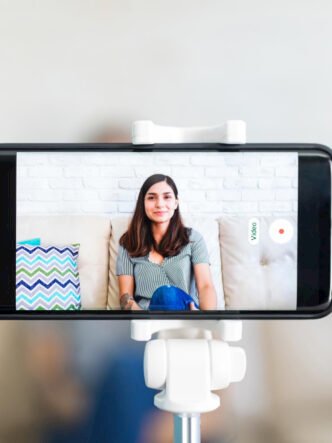Whether you want to launch a new course or scale your online education brand, you need to use videos strategically at every stage of the marketing funnel. To attract and convert learners, you can use many different types of video content. This includes explainer videos, demos, welcome videos, and testimonials. You can start by making prospective learners aware of your products and then slowly nurture them down the funnel with increasingly in-depth videos that ultimately lead to more enrollments.

Address every stage in the learner journey
Video marketing for online courses helps in the learner journey because it offers engagement that text alone doesn’t. Videos can do everything from creating a memorable first impression to helping to retain the learners post-enrolment. You can convert learners with video because it lends itself to telling transformational stories. When learners see what other learners accomplish when using you as an e-learning provider, they will also want to use your materials.
An e-learning video platform overcomes time and location constraints. Using the right video hosting platform helps you to create video content that matches the stage your prospects are at in their journey. You can’t afford to overwhelm them with too much information too soon or leave them without enough detail for them to make a sound decision.
Videos offer accessibility, convenience, flexibility, and more. It is also cost-efficient to use videos for marketing e-learning as you can create them once and use them over and over. Many prospects can access them from all over the globe at the same time without any difficulties with lagging or freezing.
Awareness stage – capturing attention
Prospective learners won’t even know your e-learning course exists unless you tell them about it in your course marketing videos. They have a problem and you have a solution for them but you have to make them aware of it. Videos made for social media, or even SEO-driven videos that answer a commonly searched-for problem, can help you to reach them. At this stage you want maximum exposure for your videos, which is why social media platforms like YouTube are so powerful at this stage.
- Short-form social media snippets can introduce a problem your course addresses and highlight an exciting benefit. You can post snippets on Instagram Reels, Facebook Reels, YouTube Shorts, or TikTok. LinkedIn posts can share quick strategies or tips.
- Explainer videos of about 80 seconds can break down what your e-learning brand is about and how it can help. An example is the Barefoot Surf School, which has good instructional videos on its website’s home page along with video testimonials. It also has day-in-the-lifestyle walkthroughs that add to the appeal on Instagram Reels and YouTube that show the adventurous experience the school offers.
- Teasers on X (Twitter) can help to build intrigue about your courses without giving too much away.
- Blog posts provide a good way to post helpful information addressing a specific topic. This provides material for search engines to crawl and you can embed a video or provide a link to one.
When creating videos for this stage of the e-learning video funnel, you need to focus on the problems learners face. “Struggling to pay attention? We can help.” Your message must be learner-centric and engaging. Include strong branding and a call to action (CTA) such as “download our free guide.”
Consideration stage – offering proof and detail
In the consideration stage, you need to help learners to evaluate whether your e-learning course is a good fit for them. They are actively comparing your offerings with those of other educators. You shouldn’t be pushy at this stage but offer yourself as a trustworthy source that can empower them to make the right decisions. Your course marketing videos can include the following examples at the consideration stage.
- Behind-the-scenes videos show them who is behind the course. When they meet the instructors or the team, it helps to humanize your brand and build trust.
- Course previews show learners ‘what’s inside’ a course. You can give a visual tour of the platform and offer lesson previews.
- Instructor intros are videos where educators talk about their experience, passion for the topic, and what learners can expect.
- Learner testimonials show prospective learners how other learners benefited from using online courses and how it changed their lives. Authentic, unscripted testimonials work best at convincing other learners that your e-learning courses will work for them too. When you localize e-learning videos, it can help to reduce barriers to learning such as cultural or language differences. Successful learners can then create video testimonials that appeal to other learners from the same culture and background as them.
- Case studies can go deeper than testimonials and give details of transformation. For instance, a case study could cover “How Rhett learned to speak English in six months.”
It’s important not to make videos in the consideration stage too corporate. You should rather focus on making them relatable. Be transparent and show real user interfaces and course materials. You can communicate with prospects and get feedback by using video messaging. This helps you to address questions, allay concerns, and highlight the type of support you can offer.
Focus on using platforms where your prospects actively research and compare options. This includes YouTube, LinkedIn, and even dedicated e-learning platforms. On YouTube you can post longer-form videos like tutorials and case studies. LinkedIn is a good platform for posting thought leadership content related to your e-learning niche. Getting known as a thought leader can be very helpful in persuading learners to use your e-learning products.

Decision stage
This is the bottom end of the funnel where prospects are almost ready to enroll. At this point you can start to create a sense of urgency and give them final reassurances.
- Demo walk-through videos are useful in this age and you can end with a CTA like “Enroll today” or “Doors close soon.” Including a bonus or limited-time offer can encourage action.
- Live Q&A or webinars allow prospects to ask questions, meet instructors, and get answers in real time. Live streaming with Q&As can help to reduce hesitations and increase conversions.
- Guarantee videos can explain your money-back guarantee and support options. Learners will look at the guarantees you offer before making their decisions. If they believe the support you offer is better than what your competitors offer, it could influence their decision.
You need to make it clear what they need to do next and add some urgency. Testimonials and stats as overlays can help to reinforce social proof. Your bottom-of-the-funnel content should help prospects to justify their purchase. Give them a really good reason why their decision to use your online course was the right one.
Post-enrollment
Your video content strategy for e-learning shouldn’t stop once you get learners to enroll. After they enroll, you need to ensure that they complete courses and you can get referrals and testimonials from them. If learners keep enrolling but they don’t complete your courses it could affect your reputation.
- Welcome videos and onboarding videos can make new learners feel part of the community right from the first day. You can thank learners for enrolling, introduce them to the platform, and help them to get started. These videos can help them to hit the ground running and make the best use of your online platform.
- Milestone videos can celebrate the progress of learners and encourage them to keep going. You could send them milestone videos in emails that they can then share with others.
- User education videos can encourage learners to keep learning. If you keep educating them, they tend to stick around.
- Company culture videos can help to encourage a sense of community that makes learners feel valued.
- Referral or testimonial request videos can encourage learners to refer a friend or leave a positive review.
If you’re an e-learning provider, Cincopa helps you to manage video across the entire funnel. It has customizable players, interactive elements, and advanced video analytics. It also integrates with software you use, such as your LMS and CRM, to make your workflows more efficient. It makes it easy for you to distribute your videos using various channels such as social media and email marketing.
Conclusion: Building a learner-centric funnel with video
Building a learner-centric e-learning video funnel helps to move learners smoothly through each stage. It will help you to use strategies that speak to their needs and motivate them to take the next step. When you keep offering them timely and relevant information, you are able to establish trust and create the type of experience that video content ultimately leads to enrollment and beyond. On Cincopa’s home page, you can sign up for a free trial and explore its solutions to effectively use video in your e-learning funnel.









